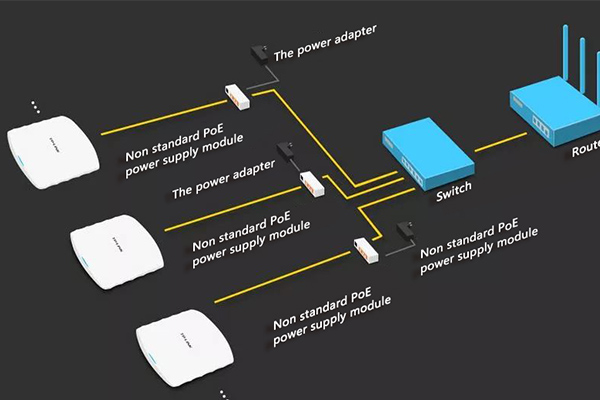【https://www.cffiberlink.com/poe-switch/】
In recent years, the development of PoE power supply technology, from 100M to Gigabit, to full Gigabit, the development momentum of PoE power supply technology is getting stronger and stronger. With a series of advantages such as simplifying the installation and deployment of electrical equipment, energy saving, and safety, PoE power supply has become a new favorite in scenarios such as wireless coverage, security monitoring, and smart grids.
However, most users still have many questions about PoE power supply. Let’s take a look at the seven common problems of POE power supply.
1. How to choose a PoE switch for security monitoring and wireless coverage
There are many types of PoE switches, ranging from 100M to 1000M, to full gigabit, as well as the difference between unmanaged and managed types, and the difference in the number of different ports. If you want to choose a suitable switch, you need a comprehensive and comprehensive consideration. . Take a project that requires high-definition monitoring as an example.
Step 1: Choose a standard PoE switch (see question 2 for the reason)
Step 2: Select Fast or Gigabit Switch
In the actual solution, it is necessary to integrate the number of cameras, and select parameters such as camera resolution, bit rate, and frame number. Mainstream monitoring equipment manufacturers such as Hikvision and Dahua provide professional bandwidth calculation tools. Users can use the tools to calculate the required bandwidth and select a suitable PoE switch.
Step 3: Select af or at standard PoE switch
According to the monitoring equipment power selection. For example, if a camera of a well-known brand is used, the power is 12W max. In this case, a switch of the af standard needs to be selected. The power of a high-definition dome camera is 30W max. In this case, it is necessary to use an at-standard switch.
Step 4: Select the number of ports on the switch
PoE switches can be divided into 4 ports, 8 ports, 16 ports and 24 ports according to the number of ports, which can comprehensively monitor the power, quantity, location of the equipment, the power supply of the switch and the price selection.
2. Why must a standard PoE switch be used for power supply?
First of all, it is necessary to clarify the difference between standard PoE switches and non-standard PoE switches. The standard PoE power supply switch has a PoE control chip inside, which has the function of detection before power supply. When the device is connected, the PoE injector will send a signal to the network to detect whether the terminal in the network is a PD device that supports PoE power supply.
The non-standard PoE product is a strong power supply network cable power supply device. It supplies power as soon as it is powered on. There is no detection step. No matter whether the terminal is a PoE powered device or not, it will supply power, and it is very easy to burn the access device.
Take Wangyue Technology MS series standard PoE switches as an example. After power-on, the switch will automatically detect the powered device. If it detects that a non-PoE powered device is connected, it will automatically stop the power supply to protect the powered device and avoid burnout. The condition of the equipment occurs, making the power supply process more secure. The detection process is as follows. Therefore, a standard PoE switch must be used for power supply.
3. How to distinguish between standard PoE and non-standard PoE is very simple, just use a multimeter to measure. Methods as below:
Start the device, adjust the multimeter to the voltage measurement position, and use the two test pens of the multimeter to touch the power supply pins of the PSE device (usually 1/2, 3/6 or 4/5, 7/8 of the RJ45 port). ), if a device with a stable output of 48V or other voltage values (12V, 24V, etc.) is measured, it is a non-standard product. Because in this process, the PSE does not detect the power receiving device (here, the multimeter), and directly uses 48V or other voltage values to supply power.
Conversely, if the voltage cannot be measured and the needle of the multimeter jumps between 2 and 10V, it is a standard POE. Because at this stage, the PSE is testing the PD side (here is the multimeter), and the multimeter is not a legal PD, the PSE will not supply power, and no stable voltage will be generated.
4. Is the PoE power supply stable?
In actual construction and application, there will still be situations where the PoE switch cannot supply power or the power supply is unstable. Is the PoE power supply really stable?
In fact, PoE technology has been developed for many years, and it is now in a very mature stage. The standard PoE power supply is stable and safe enough. Most of the situations are due to the selected non-standard PoE switch or the wire quality is too low, or the solution design itself is unreasonable, the power supply distance is not arranged well, or too many high-power devices are connected, and the power supply is insufficient (especially when the monitoring device turns on the heating mode at night). Time). Therefore, in the actual deployment, if the power supply is found to be unstable, it is necessary to investigate the external reasons first.
5. Is the higher the power of the PoE power supply switch, the better?
Due to the emergence of high-power devices such as high-definition dome cameras and real-time video phones, network equipment manufacturers are scrambling to develop PoE switches with higher total power. However, many products only pursue the improvement of total power, ignoring the relationship between power and the number of ports. When the power is high, it will inevitably increase the overall cost of the device. As a result, the PoE switch selected by the user is not very practical and cost-effective.
Therefore, in actual deployment, determine the power and quantity of PD devices according to the steps in question 1, and select the most suitable PoE switch.
6. The PoE power supply distance can only be 100 meters?
Direct current can be transmitted very far with standard Ethernet cables, so why is the transmission distance limited to 100 meters?
The fact is that the maximum transmission distance of a PoE switch mainly depends on the data transmission distance. When the transmission distance exceeds 100 meters, data delay and packet loss may occur. Therefore, in the actual construction process, the transmission distance should preferably not exceed 100 meters. However, there are already some PoE switches that can reach a transmission distance of 250 meters. For example, Wangyue MS series standard PoE switches use the L-PoE function, which can extend the PoE transmission distance to 250 meters to meet long-distance power supply. It is also believed that with the development of PoE power supply technology in the near future, the transmission distance will be extended further.
The second is the network cable. The network cable also determines the power supply distance. The network cable with the national standard exceeding Category 5 and 6 is possible, especially the national standard network cable exceeding Category 6 is definitely possible. Some customers use some cheap and poor-quality network cables, which cannot meet the distance requirements for power supply, and conversely say that there is a problem with our Fengrunda PoE switch or PoE splitter, but when we sent technical engineers over, only to find out We didn’t have any issues with our PoE switches and the issue was resolved after replacing the network cable.
There are many people who cannot distinguish whether the network cable is a regular network cable or not. There are too many fake network cables on the market. I will give you a few ways to determine the authenticity of the network cable, for reference only:
a. For a regular national standard network cable, the resistance value at a distance of 10 meters to 100 meters is less than 10 ohms. This can be measured directly with a multimeter. When it is greater than 10 ohms, such as the resistance value reaches 30 ohms, then this network cable must be fake;
b. The regular national standard network cable, a box of about 305 meters, the market price is about 450-500 yuan (the imported price will be higher), familiar friends may also buy it for 430 yuan, but if it is lower than this price, it is basically fake.
c. The regular national standard network cables are all pure copper, or oxygen-free copper, and other materials such as copper-clad iron, copper-clad aluminum, etc. are fake.
Post time: Oct-26-2022



